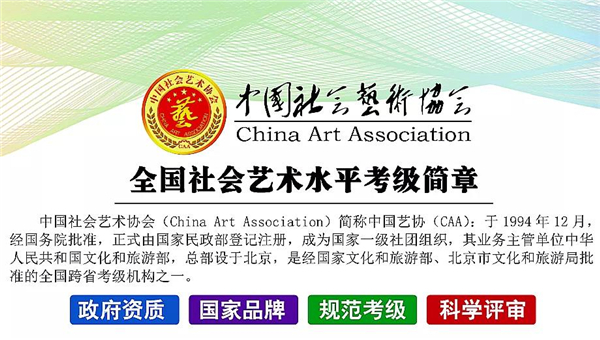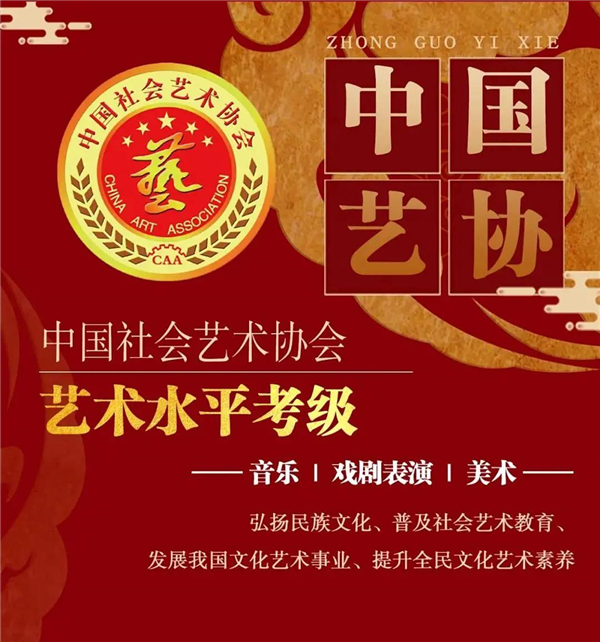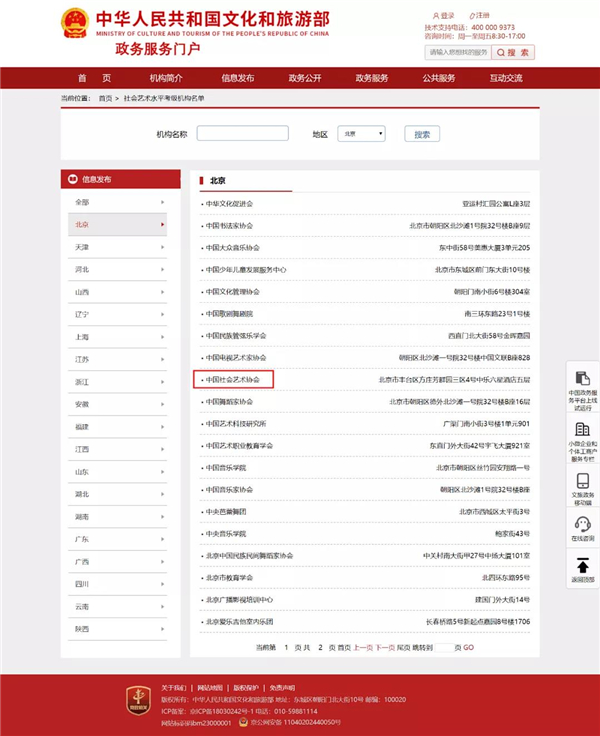China Social Art Association 2022 Social Art Level Test Guide (Qingdao Test Area)
In order to fully implement the State Council's guiding opinions on the development of social organizations and implement the tasks assigned by the Ministry of Culture and Tourism, the China Social Arts Association established the China Social Arts Association Artistic Proficiency Examination Committee (hereinafter referred to as the Grade Examination Committee). Experts and professors in various social art industries across the country have created a grading system for China's social art level. In line with the purpose of "promoting national culture, popularizing social art education, developing my country's cultural and artistic undertakings, and improving the cultural and artistic literacy of the whole people", the grading examination committee organizes, regulates and coordinates the national social art assessment work.



registered unit
Ministry of Civil Affairs of the People's Republic of China
organizer
Ministry of Culture and Tourism of the People's Republic of China
organizer
China Social Arts Association
organizer
Social Art Level Examination Committee of China Social Art Association
Grading major
music
- Music Basics
- Keyboard instruments: piano, accordion, electronic organ (single and double row keys), digital piano
- Western orchestral instruments: 1. Woodwind instruments: flute, oboe, clarinet, bassoon (bassoon), saxophone. 2. Brass instruments: horn, trumpet, tenor (euphonium), trombone, trombone, tuba. 3. Stringed instruments: violin, viola, cello, double bass, harp. 4. Percussion instruments: snare drum, timpani and percussion instruments, xylophone and marimba.
- National Orchestral Instruments: 1. Winding instruments: Bamboo flute, Sheng, Suona, Guanzi, Bawu, Hulusi, Ocarina, Xun, Xiao. 2. Stringed instruments: Erhu, Banhu, Gaohu, Jinghu, Gehu, Bass Gehu. 3. Plucked instruments: Pipa, Guzheng, Sanxian, Guqin, Yangqin, Liuqin, Yueqin, Zhongruan, Daruan and Konghou. 4. National percussion instruments.
- Vocal music: under 14 years old: children's singing; over 14 years old: popular, bel canto, ethnic.
- Others: 1. Pluck: classical guitar, folk guitar, Hawaiian guitar, electric guitar, electric bass. 2. Percussion: jazz drums (electric jazz drums), drum kits. 3. Playing class: harmonica.
dance class
- Chinese dance: Chinese classical dance, Chinese folk dance.
- International Ballroom
- Popular dances: jazz, tap, hip-hop.
- ballet
fine arts
- Chinese painting: figures, landscapes, flowers and birds.
- Western painting: sketch, sketch, gouache, watercolor, animation, oil painting.
calligraphy
Soft pen calligraphy, hard pen calligraphy.
others
Seal carving, paper cutting, clay sculpture, New Year pictures, shadow puppet making, pottery, dyeing and weaving, printmaking, photography
drama drama
- Opera performances: a. Peking Opera b. Kunqu Opera c. Local Opera: Yue Opera, Xi Opera, Yang Opera
- Drama performance: a. Children's drama performance, recitation, hosting, textbook play. b. Adult drama performance
- musical performance
folk art
Pingtan
Contents of the grade test: (If the offline grade test cannot be held due to the epidemic, it will be switched to online.)
(Note: The series of textbooks for the social art level examination of the China Society of Arts and Sciences and the series of textbooks of other grading units approved and filed by the Ministry of Culture and Tourism can be used.)
(1) Music
Vocal music: Candidates perform according to their own repertoire, fill in two songs, candidates can choose one song to sing, and the examiner can designate the second song for additional examination (candidates record the accompaniment, prepare piano and playback equipment on site, and candidates can also bring their own accompanists) .
Instrumental music: (For details, please refer to the requirements of the test materials) basic exercises, one etude, one piece of music, one polyphony (piano, drums, guzheng are provided on-site for instrumental music exams, and candidates for other musical instruments should prepare by themselves).
(2) Dance
Candidates prepare 6-8 dance combinations.
(3) Language category
Candidates are required to prepare their own reading materials for 5 minutes. Recitation examiners can also temporarily add specified recitation content.
(4) Painting and Calligraphy
- Candidates for painting and calligraphy must complete the works on the spot, unified with 4 sheets of paper, and whether the inspector invigilates the works independently.
- The time limit is 1.5-2 hours. All utensils for calligraphy and painting candidates should be prepared by themselves. (Submit when completed)
Grading fee standard
Charges:

- Deadline for registration: June 30, 2022.
- Exam Date: August-September 2022
Notes on data submission
Electronic Photo Submission Requirements
- Electronic photos must be submitted;
- The electronic version of the photo is in jpg format;
- The electronic version of the photo is required to be a small two-inch ID photo with a blue background;
- The size of the electronic version of the photo is 3.5cm*4.5cm;
- It must be named after the candidate's 18-digit ID number without adding any characters or spaces.
-
Example of electronic photo submission:

Precautions
- After the registration procedures are completed, no further procedures for level change and refund will be made. Failure to participate in the test on time will be regarded as an automatic abandonment of the test.
- If the certificate information is incorrect due to the form submitted by an individual or an organization, the cost of correcting the certificate is 30 yuan/piece. The error correction information of the certificate must be reported within one month from the date of issuance of the certificate.
- Vocal candidates: Use piano accompaniment (bring your own).
- Instrumental candidates: must prepare their own instruments.
- After the candidates pass the examination, the certificate will be produced by the examination office of the China Social Arts Association.
- The certificate can be collected from the registration institution or sent by courier. The courier fee is paid on delivery.
- Within 15 working days after the announcement of the test results, if candidates have any objection to the results, they can appeal to the Examinations Office. The video data of the test will be retrieved by the test office, and two examiners will review it and give a written reply. Candidates need to take the review score as the final score. Appeals will not be accepted after the deadline.
- Please bring the candidate's identification documents (identity card, household registration booklet, passport, etc.) with you during the test, otherwise the test will not be allowed.
13 major advantages of the China Social Arts Association in the examination
- The China Social Art Association was approved by the State Council in December 1994.
- Business Director: Ministry of Culture and Tourism of the People's Republic of China.
- China Social Art Association is the management unit of the national social art industry.
- China Social Arts Association is one of the national cross-provincial examination institutions approved by the Ministry of Culture and Tourism.
- At present, it is the most comprehensive comprehensive examination of national grade examination subjects, including (music, dance, hosting, recitation, art, calligraphy), etc.
- The China Social Art Association has precisely defined social art as "cultural art, sports art, scientific and technological art" and comprehensively promoted the work of the "National Art Talent Training Program" in these three fields. (Art + Honor + Dream = Art Life).
- The social art education series (such as: piano, guzheng) group practice standards have been formulated, which have been prepared on the national group standard network.
- The grade-examination textbooks of the China Association for Social Arts are compiled by art schools, institutions, and groups engaged in art education across the country, as well as experts, scholars, and professors engaged in art education. Each category of textbooks focuses on performance and science. The best teachers in the country form the most authoritative team of examiners.
- The examiners of the China Association for Social Arts have a good grasp of the relationship between leniency and strictness in the grade test. The primary level (level 1-3) is mainly to encourage the interest and enthusiasm of candidates. For the intermediate level (level 4-6) and the advanced level (level 7) -10) examinees require the examinee's level according to the final examination standards of professional colleges and universities, and put forward the questions that need to be solved for examinees.
- The units authorized by the China Social Arts Association for the art grading test include 35 provinces, autonomous regions, municipalities directly under the Central Government and more than 300 prefecture-level cities, and thousands of counties have test centers.
- It is beneficial for primary school students to choose schools, advance to junior high school, middle school entrance examination, college entrance examination, and to apply for scholarships abroad based on their artistic talents.
- The China Art Association owns the journal "China National Art Magazine", which collects and promotes the fine works of outstanding educators and excellent candidates in the art education industry.
- The Art Proficiency Examination Committee of China Social Arts Association has its own grading exhibition, mainly through the coverage of grading activities to fully excavate outstanding educators and showcase art teaching achievements.
 渝公网安备 50010702504639号
渝公网安备 50010702504639号